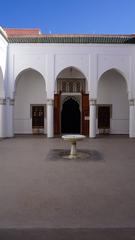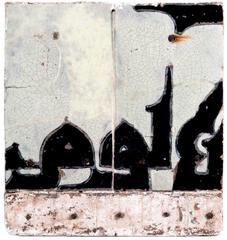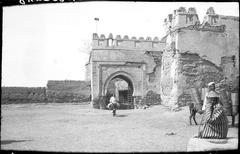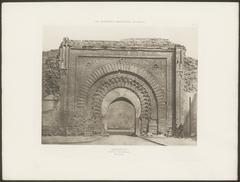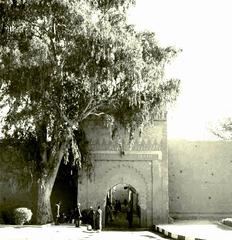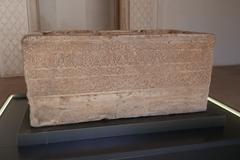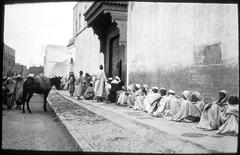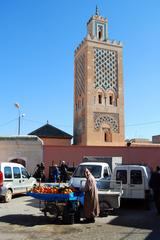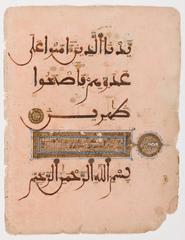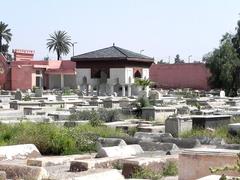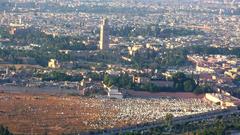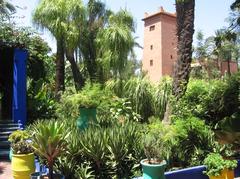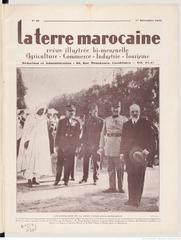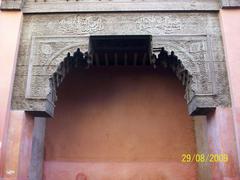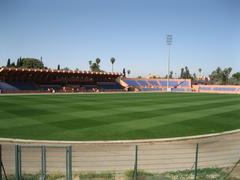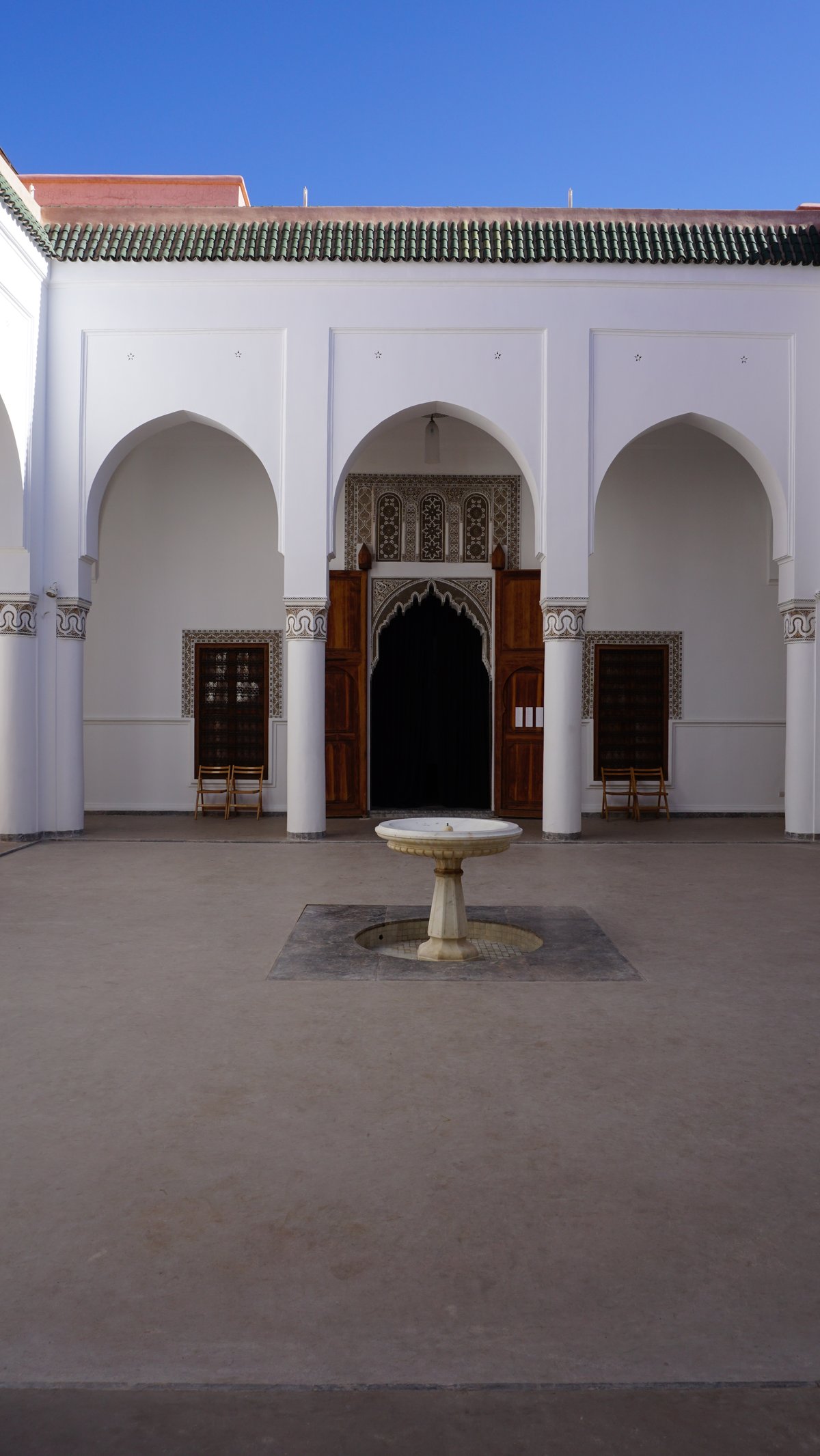
Dar Bellarj Marrakesh: Visiting Hours, Tickets, and A Guide to Historical Sites
Date: 14/06/2025
Introduction
Nestled within the vibrant heart of Marrakesh’s ancient medina, Dar Bellarj—the “House of Storks”—stands as a beacon of Moroccan architectural elegance and cultural vitality. This meticulously restored 16th-century riad not only showcases the splendor of Andalusian-Moroccan design but also serves as a dynamic foundation dedicated to preserving, celebrating, and evolving Morocco’s living heritage. Originally a sanctuary for injured storks and later functioning as a school, Dar Bellarj has continually adapted to meet the needs of its community, embodying a legacy of care, education, and cultural transmission (Morocco World News; Fondation FSB; Planet Marrakech).
Today, Dar Bellarj is celebrated for its tranquil courtyard adorned with intricate zellige tilework, carved cedar wood, and vibrant stained glass, providing a peaceful oasis amid the medina’s bustling streets. Its mission goes beyond preservation: the foundation actively promotes artistic creation, research, education, and social empowerment, particularly for women and children, through multilingual exhibitions, workshops, and public events (Dar Bellarj Fondation; Vivre Marrakech).
Located near iconic landmarks like Ben Youssef Madrasa and Jemaa el-Fnaa square, Dar Bellarj is easily accessible and welcomes visitors free of charge. This guide provides all you need to plan an enriching visit—covering history, visiting hours, ticket details, nearby attractions, and responsible tourism practices.
Table of Contents
- Introduction to Dar Bellarj: History and Significance
- Historical Background and Cultural Significance
- Practical Information for Visitors
- Nearby Attractions in Marrakesh
- Responsible Tourism at Dar Bellarj
- Frequently Asked Questions (FAQ)
- Essential Contacts and Resources
- Summary and Travel Tips
- References and Further Reading
Historical Background and Cultural Significance
Origins and Evolution
Dar Bellarj’s history stretches back several centuries, originating as a maristan (hospital) for storks—birds revered in Moroccan tradition and commonly seen nesting on the rooftops of Marrakesh’s medina (Morocco World News). Between 1950 and 1985, the building served as a community school, reflecting its longstanding role in public life (Vivre Marrakech). After years of neglect, Swiss philanthropists Susanna Biedermann and Max Alioth restored the structure in the late 1990s, establishing the Dar Bellarj Foundation in 1999 to safeguard and celebrate Moroccan culture (Fondation FSB).
Architecture and Artistic Heritage
The riad’s architecture is a testament to Moroccan craftsmanship: a spacious central courtyard is framed by four elegant salons, adorned with carved cedar wood, intricate zellige tilework, and luminous stained glass (Planet Marrakech). Marble fountains, geometric mosaics, and detailed stucco work make Dar Bellarj a living gallery of Andalusian-Moroccan aesthetics.
Foundation’s Mission and Impact
Dar Bellarj operates as a dynamic cultural center, with a mission that encompasses:
- Preserving Tangible and Intangible Heritage: Through safeguarding artifacts, oral histories, crafts, and rituals.
- Promoting Artistic Creation: Hosting exhibitions, performances, and collaborative art projects.
- Supporting Research and Education: Providing workshops in calligraphy, music, and theater, and fostering literacy, especially for women and children (Dar Bellarj Fondation).
- Empowering Community: Free entry and bilingual (Arabic/French) programs ensure wide accessibility. The foundation also works with health initiatives, such as cataract screenings in partnership with the Albassar Association (Riad Aguaviva).
Thematic Exhibitions and Programs
Each year, Dar Bellarj curates exhibitions and events that explore Moroccan identity and contemporary art, ranging from oral tradition and calligraphy to ritual celebrations like Achoura. Notable programs include Ch[a]rita, which activates public spaces across Marrakesh, and interactive workshops for all ages (Dar Bellarj Fondation).
Leadership and Recognition
After Susanna Biedermann’s passing in 2007, Maha El Madi took on the foundation’s directorship (Fondation FSB), ensuring the continued evolution of its vision. Dar Bellarj’s logo—a stylized stork—symbolizes its historic roots and ongoing connection to the city’s natural and cultural environment (Petit Futé).
Practical Information for Visitors
Location and Accessibility
- Address: 27 Derb El Hammam, Medina, Marrakesh (opposite Ben Youssef Madrasa)
- Getting There: Easily reached on foot from Jemaa el-Fnaa (10-minute walk), or by taxi to the medina’s edge. From there, follow signs or ask locals for directions (Visit Marrakech; Grumpy Camel).
Opening Hours and Admission
- Hours: Tuesday to Sunday, 9:30 AM–6:00 PM (check the official website for updates)
- Admission: Free for general entry; some workshops or special tours may require advance booking and a nominal fee.
Accessibility
- The ground floor and main courtyard are accessible to most visitors, but some areas have steps and uneven surfaces typical of historic architecture. Contact the foundation in advance for specific needs.
Guided Tours and Workshops
- Guided Tours: Available by prior arrangement, offering deeper insight into Dar Bellarj’s history and programs.
- Workshops: Regularly scheduled on calligraphy, traditional crafts, music, and storytelling. Advance booking recommended for limited spaces.
Visitor Services and Tips
- Languages: Arabic and French are standard; some English materials and multilingual staff available.
- Photography: Generally permitted; please be respectful during events or when photographing people.
- Dress Code: Modest attire is advised out of respect for local cultural norms.
- Facilities: Restrooms are available; the courtyard offers a serene spot for rest and reflection.
- Best Times to Visit: Mornings are quieter; afternoons can be busier, especially during special events.
Nearby Attractions in Marrakesh
- Ben Youssef Madrasa: Exquisite Islamic architecture, steps from Dar Bellarj (source).
- Marrakech Museum: Moroccan art and historical collections in a grand palace.
- Almoravid Koubba: Unique domed relic from the 12th century (source).
- Jemaa el-Fnaa: Lively UNESCO-listed square with markets, food stalls, and performers (source).
- Koutoubia Mosque: Marrakesh’s largest mosque, admired for its exterior and gardens.
- Souks of the Medina: Traditional markets for spices, textiles, and crafts.
- Jardin Majorelle: Iconic botanical garden, a short taxi ride away (source).
Responsible Tourism at Dar Bellarj
- Cultural Sensitivity: Dress modestly, ask before photographing locals, and respect religious or cultural events.
- Supporting Local Communities: Engage with artisan workshops, purchase local crafts, and consider making donations to support programs.
- Environmental Responsibility: Reduce water and plastic use; dispose of waste properly.
- Respecting Heritage Sites: Avoid touching art or architecture; follow guidelines.
- Ethical Shopping: Choose fair-trade, locally made goods and bargain respectfully (Visit Marrakech).
- Engage with Local Initiatives: Participate in educational programs and support community events.
- Global Guidelines: Follow responsible tourism principles from organizations like UNWTO.
Frequently Asked Questions (FAQ)
Q: What are the opening hours of Dar Bellarj?
A: Tuesday–Sunday, 9:30 AM–6:00 PM. Closed Mondays and some holidays.
Q: Is there an entry fee?
A: General admission is free. Some workshops or special tours may require a fee.
Q: Is Dar Bellarj accessible for visitors with limited mobility?
A: The courtyard and main areas are accessible; some rooms have steps or uneven surfaces.
Q: Are guided tours available?
A: Yes, by prior arrangement or during special events.
Q: Can I take photos inside?
A: Photography is allowed in public areas; please ask before photographing exhibitions or during events.
Essential Contacts and Resources
- Dar Bellarj Foundation: Official website
- Tourist Information: Marrakech-Safi Regional Tourism Council
- Cultural Agenda: Vivre Marrakech’s cultural calendar
- Emergency Services: Police: 19 | Medical: 15
Summary and Travel Tips
Dar Bellarj is a living testament to Marrakesh’s cultural and architectural legacy. Free admission, central location, and a diverse calendar of workshops and events make it an essential stop for anyone interested in Moroccan heritage. To make the most of your visit, check current hours and event listings, book workshops in advance, dress modestly, and engage with the local community. By supporting Dar Bellarj’s mission and practicing responsible tourism, you contribute to the preservation and celebration of Morocco’s unique cultural tapestry (Dar Bellarj Fondation; Lonely Planet; Vivre Marrakech; Visit Marrakech).
References and Further Reading
- A Journey in Marrakech: Seven Places Not to Miss, Morocco World News
- Fondation Dar Bellarj, Fondation FSB
- The Best Art Galleries and Museums in Marrakech, Planet Marrakech
- Dar Bellarj Foundation Official Website
- Maison des Cigognes, Vivre Marrakech
- Dar Bellarj Museum, Visit Marrakech
- Tips for Visiting Marrakech, Grumpy Camel
- Dar Bellarj, a Cultural Foundation in Marrakesh, Riad Aguaviva
- Dar Bellarj Attraction, Lonely Planet
- Petit Futé
- UNWTO: Responsible Tourist Principles
- The Broke Backpacker: Best Things to Do in Marrakech
Visual suggestion: Include photographs of Dar Bellarj’s courtyard, tilework, and cultural events, as well as interactive medina maps for enhanced visitor planning.
